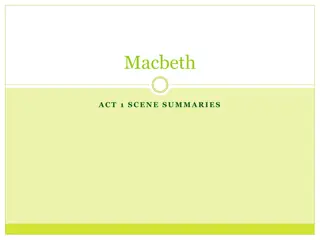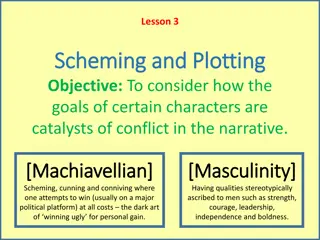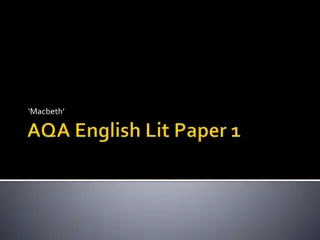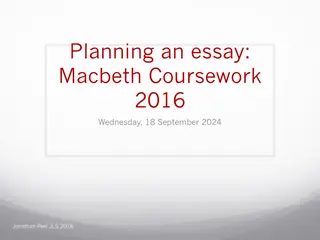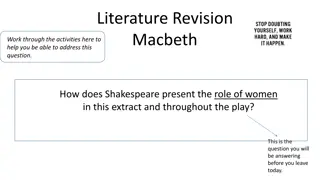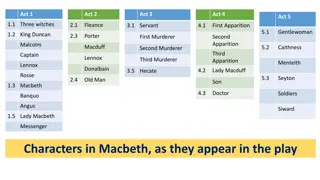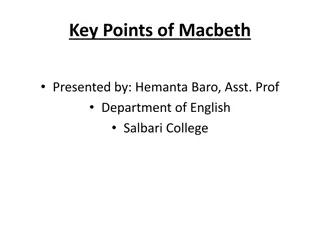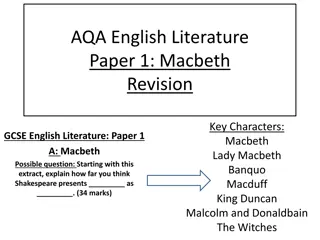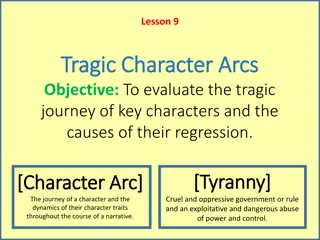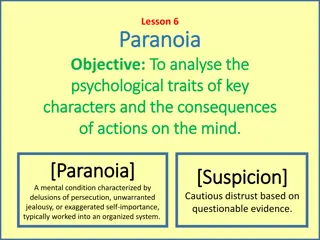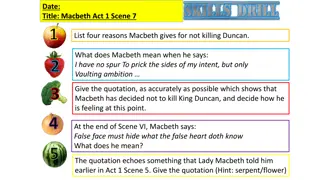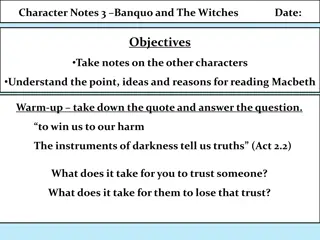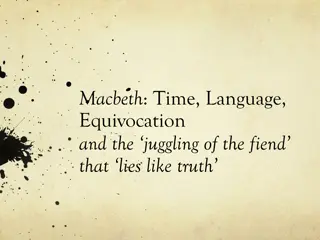Analyzing Lady Macbeth as a Fiend-Like Queen in Shakespeare's Macbeth
Explore the portrayal of Lady Macbeth as a fiend-like queen in Shakespeare's play Macbeth. Consider the context of creation, language, form, and structure to unravel the complexities of her character, from her ambition-driven manipulation to her descent into guilt and madness.
Download Presentation

Please find below an Image/Link to download the presentation.
The content on the website is provided AS IS for your information and personal use only. It may not be sold, licensed, or shared on other websites without obtaining consent from the author. Download presentation by click this link. If you encounter any issues during the download, it is possible that the publisher has removed the file from their server.
E N D
Presentation Transcript
Jonathan Peel JLS 2016 Coursework B Monday, 16 September 2024
Outlines Assignment B The assignment should be based on one of the literary heritage texts listed below. The assignment will be marked out of 30 with 10 marks for AO1, 10 marks for AO2 and 10 marks for AO4. A choice of one text from Literary Heritage Romeo and Juliet William Shakespeare Macbeth William Shakespeare The Merchant of Venice William Shakespeare Pride and Prejudice Jane Austen Great Expectations Charles Dickens The Scarlet Letter Nathaniel Hawthorne Jonathan Peel JLS 2016
Content Setting the question Assignment B must allow students to access AO1, AO2 and AO4. Assignments could take one of the following formats: Jane Austen allows the reader to see many different forms of love in Pride and Prejudice. To what extent do you agree? You must consider language, form and structure and refer to the context of the novel. How does Dickens portray city life in Great Expectations? You must consider language, form and structure and refer to the context of the novel. Teaching should focus on the study of whole texts, developing students comprehension and critical reading, as well as their ability to produce clear and coherent writing using accurate Standard English. To help students develop their skills, wider reading of literary texts is also encouraged. Jonathan Peel JLS 2016
AOs Jonathan Peel JLS 2016
MARKING NOTE: The heading clearly suggests awarding up to 10 marks for each of the 3 AOs. This means that a clear balance must be established. Jonathan Peel JLS 2016
How does Shakespeare present Lady Macbeth as a fiend-like Queen ? Consider the context of creation, language, form, and structure in your response. Jonathan Peel JLS 2016
Plan: long view idea Establish fiend like as alluding to Hell Place the Quotation Establish 1606 as a time of approaching apocalypse in many minds breaking of the great Chain Introduction Expectations of 17C: modest LM breaks this with comments about M disloyal and disrespectful / comments about babies and killing thereof Chain Breaker? Jonathan Peel JLS 2016 LM seeks to remove femininity and become . What? Milk/gall? Murdering ministers? Regicide=sin=chain break Chain Breaker Setting of this: Castle. Becomes HELL as metaphor after Porter. LM as Hellish as Queen of Castle and in control Or link to Weird sisters in some way? Look closely at the text Chain Break Focus on Structure she does increasingly little and her influence is lost She has a conscience and feels guilt. She kills herself as a result of her sin indicates that the chain may not be irreparably broken. SHIFT
KEY MOMENTS 1.5 Establishes her lack of respect for M and her ambition to rise too far vaulting ambition seeking to break the chain fatalentrance of Duncan shows she is already decided on action. 1.5 unsex me now speech establishes her wishing to lose femininity and become an instrument of death. Jonathan Peel JLS 2016 1.7 Controls Macbeth and forces him to the deed 2.2 Offers comfort to Macbeth in the context of seeing him as weak roles reversed (fair is foul) 3.1 &3.3 Explaining Macbeth s behaviour and showing as the sane force in the castle 4.3 A contrast with Lady MAcDuff who is modest 5.1 Guilty conscience. Death will be unmourned by Macbeth. Chain break has failed and all who break are punished like Guy Fawkes
Contexts 1605: Year of Guy Fawkes plot to murder King James. Seen as a sign of the Breaking of the Great Chain. A real Scottish King has just avoided murder Plotters put on trial in 1606 events are contemporary to the play. Porter s humour reflects the attitude to the trial Equivocation- lying to seem good is used at trial and seems to undermine all society if lying is seen as a way to avoid punishment, then there is no hope. Women in society expected to be modest in every way after the death of QE1 there is less need to show strong women. LM breaks the mould in every way by denying her womanhood. Jonathan Peel JLS 2016
Engages with plot Clear knowledge of structure of the play Establish terms of the question At the end of the play in Act 5.9, Malcolm, newly installed as King of a war-torn kingdom calls Lady Macbeth a fiend-like Queen . The implication is clear: a fiend is a devil and Thus Lady Macbeth is seen as a devilish and cruel character. Shakespeare has developed her character throughout the play in order to, first, show her fiend-like qualities and then to suggest that she might be suffering from her conscience, despite being so far sunk in sin that there can be no redemption. A contemporary audience would recognise her departure from the expected norms of feminine behaviour and her willingness to invoke the spirits that tend on mortal thoughts as signals that she is as much in breach of the Great Chain of Being as was Guy Fawkes, who was on trial for attempted Regicide Immediately before this play was first produced. Jonathan Peel JLS 2016 Contextual knowledge and focus on question established. Awareness of context of creation Knowledge of the text: no analysis in introduction


